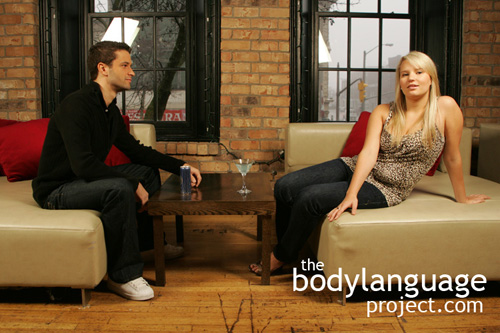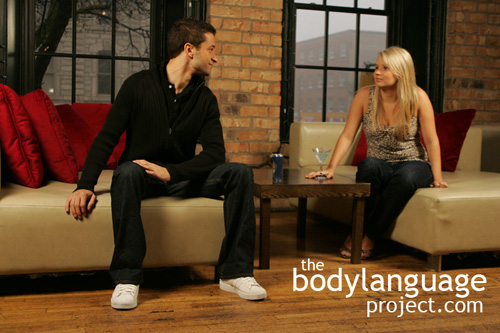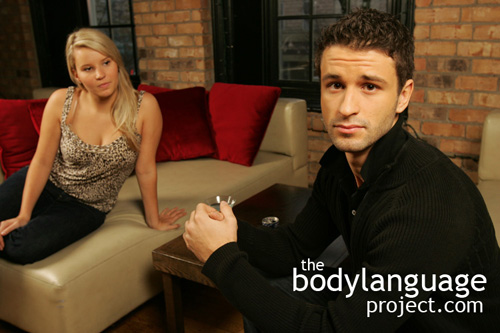The final type of boss is the laissez-faire type. The words “laissez-faire” is French for “let be”. Literally, this boss will give an employee free reign, or seemingly so. They have confidence in the ability of others to do a good job, and check in only occasionally to measure progress. This boss will be relaxed and not status conscious, they will try to avoid others as much as possible to afford them the room and space they need to work. They might be friendly, but lack eye contact and expression so as not to become involved with others and take them off task. To work well with this boss, use confident and independent body language. Give off signals that you are working efficiently and are coping with any project given to you. Keep meetings short, update them of your progress every so often, then get back to work.
Tag Archive for Confidence
Smiling And Gazing Advice For Men
by Chris Site Author • March 6, 2013 • 0 Comments
Smiles mean a lot more than just happiness, such as fear and stress. However, smiles due tend to appear most from happiness, and as a result of genuine feelings of optimism. They also indicate confidence and hopefulness. We know that smiles are infectious, yet men hardly ever sport them. I suppose men’s lack of smiles has to do with the vast amount of testosterone that courses through their bodies, coupled with the fear of appearing subordinate to others, but men should not let that be a deterrent. If men walk through life with a big grin, people will notice and stop them, wondering what good news they hold, or what successes they have achieved.
Laughter and smiles, when done by men, show women that they have interesting and successful lives. Men can easily try a smile experiment to measure the exact value it has, and they’ll know they’re onto something when they receive smiles in return. While it is true that some smiles won’t be well received, be they ignored or returned with a grimace, it shouldn’t deter the smile experiment from continuing. The object isn’t to impress everyone, rather it is to plan seeds in the minds of others that you are friendly, open to conversation, and that good things happen to you, and that if they associate with you, these good things might benefit them too.
Even stone faced women can be broken by persistent smiling so long as it is done properly. When smiling, men should never face women straight on, rather they should smile at an angle. The straight on look can be construed as aggressive and confrontational. Men should always break smiles by looking down, not away, up or to the side. A downward look shows that you are prepared to submit and that you are not a threat. If eye contact is made, keep it brief, lasting less than three seconds and always add a small genuine smile with head cocked at forty-five degrees. Avoid head on stares, prolonged looks, or abnormal or persistent eye widening, as these will surely send the wrong message.
Even if women don’t respond immediately, it doesn’t mean that a future encounter won’t lead to positive things. In public we are habitually in displacement mode so most women initially see people as objects rather than people worthy of interaction. Men should understand that women find others, especially strange men, as potential threats to their safety. If, or rather when, because after all this is a numbers game, a man finds a willing participant, the sensation will be immediately exhilarating for both parties. However, smiling isn’t the end of the story, it’s the start. Smiling endlessly can become creepy so if invitations to conversation seems welcome, graduate to verbal dialogue and take things to the next level. If your experiment fails miserably, try adding a sharp nod or even a joyous “hi”, “hey”, or “hello.” A verbal connection or a more obvious nonverbal signal can serve to snap people more forcefully out of their public displacement.
Smiles are inexpensive so don’t be afraid to use them, but do keep in mind that the vast majority of people, especially in crowded urban areas, might ignore them totally. Remember though, that just because the cues are ignored does not mean that it is a personal rejection, since logically, these people have no sense whatever about the smiler, they don’t even know them! Remember too, like a lot of things in life, smiling-success is a numbers game.
How Men Can Use Negative Body Language
by Chris Site Author • March 6, 2013 • 0 Comments

“Pecking forward” is a negative body posture for men in courtship because it makes him seem needy and low value.
Men should make all their movements more planned, deliberate, and purposeful. Leaning in too much, also referred to as “pecking” forward, is a big fault most men make. Leaning back will force others to engage you, instead of the other way around. Talking quietly also has the affect of forcing people to move closer to you, thereby increasing your status but if done too frequently appears submissive and unconfident.
Don’t be afraid to use negative body language when people do things you don’t like. If they “start on you”, don’t be afraid to turn your back or cross your arms. At the same time, men should display honest and genuine interest and try to build others around them up, but at the same time force them to work for their approval. Most everyone has a sore spot for validation and if you can become a root to their confidence, then they will seek you for approval which gives you the power. However, men shouldn’t be afraid to show interest either. Body language like verbal language is a negotiation.

Does he really want to leave? In most cases, negative body language is truthful, but he’s playing a game – hard-to-get!
One negative body language technique involves talking over a shoulder so as to show some but not total interest in someone. If done correctly it, the body language teases woman and forces them to display stronger signals of interest to keep the man’s attention. That is if she’s been given enough cues to feel compelled to compete for your attention. Using negative body language in this way is especially attractive to women who habitually have men fawning all over them. Far too often men use body language that is open an accepting in all cases and situations even though women don’t fully and sometimes not even partially deserve it. Negative body language shows rejection, which a lot of women are not accustomed to so it brings out their competitive spirit.
Above: Playing hard to get can sometimes put you back in the driver’s seat with women. For example, you could display a carefree attitude by slouching lower in a seat, opening up your posture, and taking up more space than necessary to demonstrate dominance. This may excite certain women since you are displaying as a typical alpha male, but if you go overboard, it will turn women off.
Turtling – It’s When The Head Goes Into It’s Shell
by Chris Site Author • March 6, 2013 • 0 Comments

Turtling is a limbic response to confrontation. The head sinks, shoulders shrug, and the body takes on a smaller form to avoid being seen as a threat.
The posture happens as the head seems to sink inside the shoulders, however, what is really happening is that the shoulders are slowly being raised so the neck disappears taking the head with it. It is as if the head is being swallowed by the shoulders. We see this posture when people are uncomfortable, have low confidence about themselves or a topic, have insecurities, feel weak or powerless, ashamed, or are carrying any other negative emotion. It is usually found when someone is centered out on their poor performance. The origins of the head turtle is to protect it from harm. For example, when people hear a very loud bang, they will quickly pull their heads inward and down, and tuck their chins. However, when it is done out of shame, it happens more slowly and deliberately so as to draw even less attention.
It usually happens when people want to appear less significant so they are ignored rather than called on. In business the head duck will occur when subordinates meet with superiors as they try to stand out less and look less significant or when employees wish to be overlooked during status reports at a boardroom meeting. It might also happen in class when the professor is calling on students who don’t have the answers, or when athletes have to walk back in shame to their dressing rooms after losing an important match.
Summary – Chapter 10
by Chris Site Author • March 6, 2013 • 0 Comments
In this chapter we looked at attentive and evaluative body language. Here we defined attentive in terms of active participation in a conversation or presentation and evaluative in terms of thought or processing of information to reach a decision. We saw that undivided attention is obvious when a rate of eighty percent eye contact, or nearly so, is achieved while being listened to, and whilst speaking occurs at a rate of sixty percent with any significant deviation representing a loss of attention. We saw that fidgeting or repetitive behaviours such as tapping the toes, swinging the feet or drumming the fingers can signal boredom. We covered other boredom indicators like the body sagging or slouching in a seat, leaning against the wall or dropping the head.
We then moved onto agreement indicators and found that slow nodding shows general agreement, but that quick nodding can show impatience or a desire to interject and also that the brain is hardwired to think positively either when nodding or viewing nodding by others. Next we learned that when the hand holds the chin it shows varying levels of negative thoughts by how much weight it supports. The more the weight held by the hand, we saw, the more boredom present.
We then looked at other evaluative body language such as chin stroking, signifying that the decision making process had begun but that a conclusion had not yet been reached, what glasses mean, peering over the glasses means judgment, hand steepling which shows confidence and hidden superiority, and neck rubbing, which is a restraint posture indicating negative feelings. Lastly, we covered additional evaluative body language such as stroking the side of the nose, flared nostrils, pinching the bridge of the nose, looking upwards, or looking around the room, but cautioned that some of these same gestures can be indicators of other thoughts. For example, we learned that looking up might also mean that someone is in disbelief and is ‘sending a prayer to God.’ We found that flared nostrils can also mean an internal judgment is forming, agitated or even aggression. We concluded that when we witness evaluative gestures we should prepare to mount a better case, or prepare for a possible negative outcome.
Hand Steepling
by Chris Site Author • March 6, 2013 • 0 Comments
The hand steeple happens by propping up the fingers of on hand, with the finger of the other hand, to form a bridge. In this posture fingers are not interlocked and the palms do not touch. The word steepling comes from their similarity to the pointed roof of a church steeple. Rocking, might accompany the steeple where the hands move back and forth by adding and reducing pressure between them. The steeple can be placed low on a lap, or seen hovering slightly above the lap. Other times the steeple is in full view of others with the elbows propped up on the table. The steepler can hold the posture so high that they have to look through the steeple to see others. Hand steeples frequently occur by themselves as standalone cues, and don’t require additional body language in a cluster to have predictable meaning.
The steepler is someone that is confident, sometime overconfident, genuine, authoritative, and particularly evaluative of others around him. Confidence, in this case, is held in the power and control they possess and also in knowing things that other people do not, so steepling says “I have access to hidden information (and life experience) and this is the source of my power and control over you.” Steeplers are found carrying the gesture when around subordinates, or whenever they seem to have the upper hand. Donald Trump performed the steeple frequently on his television show The Apprentice, in preparation, of all things, to fire his next apprentice! His steepling was an obvious cue to the power he had over his subordinates. This gesture is effective if you already possess power or want others to think you do, but it is ineffective in team building, since it comes off as arrogant. It does have subconscious manipulative properties though, such as bluffing in poker but in most cases, this gesture is only as effective as that which can be backed up with real confidence and true access to valuable hidden information.
Superiors will also be seen using this gesture in meetings and when giving orders and the higher the steeple is held, the greater the arrogance it depicts. In extreme forms, the person carrying the gesture can be seen “looking right through their hands” between the triangle formed by the pent up fingers and the thumbs. A more subtle version is the hidden steeple of which the sender could be trying to hide or shelter their opinion from view by keeping the steepled fingers below the table. The lower steeple is more often used by women and when someone is listening rather than speaking. Hidden steepling refers to hidden confidence or a desire to limit arrogance in attempt to appear more open and accepting. The underlying meaning of the steeple is still present however, yet women should show more overt confidence by actively mirroring or initiating steepling on their own to gain an advantage in office situation, rather than letting their confidence fall to the way side. In all confident steepling the hands remain stand-alone, or the elbows serve to prop the hands up from a table. When the hands are steepled, but holding support to the head, it does not signal confidence, but rather boredom, self consciousness, or awkwardness.
 The steeple can occur in body language clusters as well, but what is important is not what happens after the steepling, as in the chin stroke and eye glass language, but rather what happens preceding the steepling. Therefore, by watching for positive open postures such as palms up and arms un-crossed or closed postures such as arms crossed, touching the nose or face and avoiding eye contact, we can tell if the person is trying to be honest or manipulative with his or her apparent power. In other words, steepling is a finish posture serving to punctuate a body language clue cluster rather than the other way around. Steepling can also ebb and flow along with confidence to what is being said which can be useful in negotiations or in arguments. If something is said to drop confidence the steepling might be broken in favour of interlocked hands as if praying but then quickly return when a person feels that their position has improved. Interlocked fingers is a signal of low confidence and the fingers might even be seen wringing themselves. Lawyers quickly learn to control this nonverbal cue in favour of constant steepling rather than any other gesture.
The steeple can occur in body language clusters as well, but what is important is not what happens after the steepling, as in the chin stroke and eye glass language, but rather what happens preceding the steepling. Therefore, by watching for positive open postures such as palms up and arms un-crossed or closed postures such as arms crossed, touching the nose or face and avoiding eye contact, we can tell if the person is trying to be honest or manipulative with his or her apparent power. In other words, steepling is a finish posture serving to punctuate a body language clue cluster rather than the other way around. Steepling can also ebb and flow along with confidence to what is being said which can be useful in negotiations or in arguments. If something is said to drop confidence the steepling might be broken in favour of interlocked hands as if praying but then quickly return when a person feels that their position has improved. Interlocked fingers is a signal of low confidence and the fingers might even be seen wringing themselves. Lawyers quickly learn to control this nonverbal cue in favour of constant steepling rather than any other gesture.
Head Back And Peering Over Glasses
by Chris Site Author • March 5, 2013 • 0 Comments
While the cue can be done without glasses, peering over them by slightly pulling them down as if to get a better view is even stronger. A friend of mine who is a photographer explained to me that he felt turned off by a client that habitually held this posture. For whatever reason, it was her natural tendency to tilt her head back and look down the bridge of her nose at the camera. Since the nose and chin move together they both signal the same sort of high confidence dominant signal. At the time he didn’t know why but was quick to have the model drop this posture because it didn’t feel right to him. I explained to him that he likely felt put off by the posture because it made her appear dominant and authoritative when he was likely looking for a coy pose instead. I was right after all. His reply “Why would anyone want to look at a domineering model peering down on her subjects?” He then explained that he wasn’t doing a stock photo for a fluff editorial, rather “She wanted to look attractive for her boyfriend!” We both found this amusing; he would have received an interesting surprise!
Standing Positions And Their Hidden Meaning
by Chris Site Author • March 5, 2013 • 0 Comments
There are four main ways in which a person might stand [a] Straight up with their feet together [b] feet slightly apart, but parallel [c] one foot forward and [d] legs crossed at the ankle.
The first posture with the legs straight and feet together is an attentive pose seen in obedient children when speaking to their parents. It is a neutral, honest pose and is found in adults of differing status like a boss and his employees. The second pose, as we saw earlier, where the legs are spread at shoulder width while standing, is a form of crotch display. This posture says “I’m going nowhere, and fast.” The standing crotch display can be made even more powerful by adding the thumbs in a belt loop, called the “cowboy pose.” The cowboy pose was made famous by old Western movies. The third posture where one foot is moved forward, with respect to the other, indicates subtle interest toward the direction in which the foot is advanced. To show interest, the foot will be moved toward the speaker, but it can also be moved away from the speaker toward someone we would rather have speak, or to the door when we wish to end the conversation. The foot takes the “first step” toward where the mind wishes it where.
The final pose where the legs are crossed at the ankle is a submissive posture. It reveals that the target isn’t ready to commit to a proposal, and shows reservation to the situation, but also that he isn’t ready to leave. The ankle cross is figurative denial of access to the body and mind. Our minds and bodies are linked so when we uncross our bodies we show others that we are willing to hear them out, which is an excellent indication that, our opinions either already match, or that there is at least a willingness to consider the facts.
An open posture while standing shows supreme confidence because it exposes the midsection to attack. When people meet for the first time, they will show timidity by crossing at the ankle. In fact, this is the most common way in which people will stand when meeting new people, those exempt will both, carry a higher status, and be aware of it.
Arm crossing, or tucking the hands in pockets, are two other ways to raise barriers when uncomfortable. These posture don’t mean negativity per se, they are simply indications that someone needs more time to acclimatize themselves to new people. Introverts over extroverts, will be found to hold this posture for much longer and more frequently than extroverts. In fact, extroverts might warm up to people so fast that they never show timidity at all, they usually jump right into any group and feel at home. When dealing with an introvert, on the other hand, offer to take them to a quiet and less busy environment to make them more comfortable. Offering a drink too, can give their hands something to do to breaking their rigidity. Providing an environment where your ideas might stick, first begins by removing barriers, even if they are nonverbal.
__________________________________________________________________________________________
__________________________________________________________________________________________
__________________________________________________________________________________________
You Have Four Minutes!
by Chris Site Author • March 5, 2013 • 2 Comments
It has been repeatedly shown that the first four minutes are crucial to formulating life-long impressions of others. The research has shown that the reality of the matter is that it might even be shorter than this. [!dw-post-more level=”0″]Once a judgment has been past, people will vigorously resist changing it. In fact, our first impressions are so strongly held, that we’d prefer to ignore, omit or distort information about someone as it comes in that doesn’t fit our impressions than to modify our initial impressions of someone. Add to this, the fact that only some our time formulating impressions is done verbally through speaking, but all of our time is spent sending signals nonverbally. Our impressions are made passively, regardless of our desire to create them, so being caught on an off day can really hurt future relationship. If, say, for example, we are caught in a bad mood, or happen to be dealing with a rare crisis, the judgment others make during this period will follow us for a very long time. Shy people who take longer to warm up to others know this all to well and are often reminded of this fact later. As their relationships flourish, friends will tell them how their initial impressions of them were quite different from the person they have come to know. Being shy holds their true personalities from sight, and this hurts them in the short term because the initial impression they make comes across as indifferent and cold.
Knowing that impressions are so important, we can use it to our advantage by placing added emphasis on initial impressions and concentrate our efforts. Once this time has elapsed, we can either relax back to our regular selves and allow our newly created reputation to keep us afloat, or maintain out initial behaviour. The choice will be ours to make. This book will cover the all important job interview and skills to portray confidence and knowledgeable and how to pack it all into the typical four minute interview. Fortunately, this book is almost entirely about formulating and maintaining good impression. [/dw-post-more]So the rule here is to never ignore the power of first impressions. More often than not, first impressions are the ones that last for an entire relationship and can’t be easily corrected later. I should also emphasis that what you ‘say’ is often far less important than what you ‘do’. Listening, and using strong body language will illustrate a much stronger impression then being a good speaker, so always pay more credence to positive body language.









